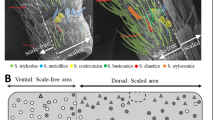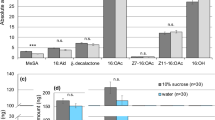Abstract
The sex pheromones, with which female moths attract males, normally consist of a mixture of several chemicals, usually aliphatic alcohols, acetates and aldehydes1. In the small number of species which have been studied in detail, particular combinations of compounds have been shown to elicit each of the major stages of the approach of the male to the female2–4. However, little distinction has been made between the chemical signals which allow the male to orientate towards the female, and those which elicit specific responses such as landing and courtship behaviour. Recent studies on the mechanisms whereby male moths navigate towards pheromone-producing females have concentrated on single chemicals, or fixed blends of chemicals, and have not considered the separate roles of individual compounds within a blend5,6. In our studies of the responses of male pine beauty moths, Panolis flammea (Schiff.) to the sex pheromone produced by the female, we have now demonstrated that both landing and copulatory behaviour are elicited by different chemical stimuli to those which serve to orientate the male at each of these stages.
This is a preview of subscription content, access via your institution
Access options
Subscribe to this journal
Receive 51 print issues and online access
$199.00 per year
only $3.90 per issue
Buy this article
- Purchase on Springer Link
- Instant access to full article PDF
Prices may be subject to local taxes which are calculated during checkout
Similar content being viewed by others
References
Roelofs, W. L. & Carde, R. T. A. Rev. Ent. 22, 377–405 (1977).
Baker, T. C., Carde, R. T. & Roelofs, W.L. J. chem. Ecol. 2, 333–352 (1976).
Baker, T. C. & Carde, R. T. Envir. Ent. 8, 956–968 (1979).
Linn, C. E. & Gaston, L. K. Envir. Ent. 10, 751–755 (1981).
Murlis, J. & Bettany, B. W. Nature 268, 433–434 (1977).
Kennedy, J. S., Ludlow, A. R. & Sanders, C. J. Nature 288, 475–477 (1980).
Baker, R., Bradshaw, J. W. S. & Speed, W. Experientia 38, 233–234 (1982).
Jones, O. T., Lomer, R. A. & Howse, P. E. Physiol. Ent. 6, 175–181 (1981).
Snedecor, G. W. & Cochran, W.G. Statistical Methods (Iowa State University Press, 1967).
Author information
Authors and Affiliations
Rights and permissions
About this article
Cite this article
Bradshaw, J., Baker, R. & Lisk, J. Separate orientation and releaser components in a sex pheromone. Nature 304, 265–267 (1983). https://doi.org/10.1038/304265a0
Received:
Accepted:
Issue Date:
DOI: https://doi.org/10.1038/304265a0
This article is cited by
-
Three Novel Bile Alcohols of Mature Male Sea Lamprey (Petromyzon marinus) Act as Chemical Cues for Conspecifics
Journal of Chemical Ecology (2017)
-
How neurons may compute: The case of insect sexual pheromone discrimination
Journal of Computational Neuroscience (1994)
-
Ecdysteroids as a component of the genital sex pheromone in two species of hard ticks,Dermacentor variabilis andDermacentor andersoni (Acari: Ixodidae)
Experimental & Applied Acarology (1991)
-
Sex pheromone of the european sunflower moth,Homoeosoma nebulellum (Den. & Schiff.) (Lepidoptera: Pyralidae)
Journal of Chemical Ecology (1991)
-
Roles of minor components in pheromone-mediated behavior of western spruce budworm male moths
Journal of Chemical Ecology (1990)
Comments
By submitting a comment you agree to abide by our Terms and Community Guidelines. If you find something abusive or that does not comply with our terms or guidelines please flag it as inappropriate.



